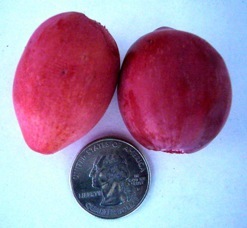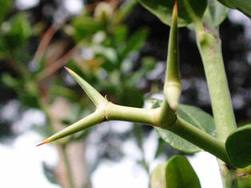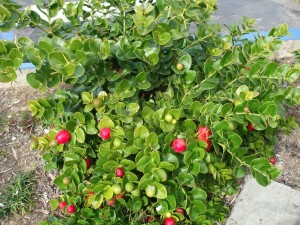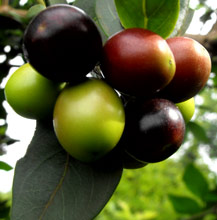Natal Plum: Incredible Edible Landscaping
A good reputation is hard to maintain when your closest relative has a reputation for killing people. That’s the public relation situation for the Natal Plum.
There are few foraged fruits that can match the Natal Plum in sheer deliciousness. Yet, it is a member of one of the most deadly plant families along side its cousin the Oleander, which makes headlines by fatally poisoning the unknowing and the suicidal.
Officially known as Carissa macrocarpa (kuh-RISS-uh mack-roe-KAR-puh) the Natal Plum is part of the Dogbane family. The botanical name for that family is Apocynaceae which is Greek for “keep it away from the dog” meaning it kills them easily. It does us, too. Nearly all parts of the Natal Plum are poisonous, like the Oleander, except for the red-ripe fruit. They taste like a slightly sweet cranberry with the texture of a ripe strawberry — some say like a sightly unripe cherry. It’s surprising that someone hasn’t concocted a commercial fruit juice that tastes like the Natal Plum. If they mixed it with some orange juice it could be Natal Naval… lot of marketing possibilities there.
As for the Oleander, it is one of the deadliest shrubs in Florida, not the deadliest plant but certainly in the top three. It’s commonly used in landscaping along highways because it can tolerate heat and all the heavy metals and exhaust and other transportational effluvia vehicles spew such as rubber, asbestos, motor oil, grease, paint et cetera. Accidental and intentional deaths from Oleander poisoning are common. When you have a toxic relative like that, you can see how good side of the Natal Plum tends to get lost.
Natal Plum copes well with salty winds, making it a good choice for coastal areas. It grows in mounds two to seven high and as wide. It’s tolerant of various lighting conditions and is a popular landscaping plant. Because of its double spines —a good identification characteristic —it makes a popular security hedge. The Natal Plum in the accompanying pictures came from a vacant commercial lot in Orlando. I drove past it often in the distance and curiosity upon seeing red prompted its discovery. I’ve also seen it as a landscape plant inside the national Canaveral Seashore Park — across the road from the rangers’ headquarters on a sand dune — and in the dry hills of San Diego, California.
Natal Plums have shiny, deep green leaves and snowy white flowers. Their scent intensifies at night and they bloom for months at a time. The fruit appears in summer and fall, or fall and winter in warmer climates, and at the same time as it blooms. In moderate climates the fruits can appear throughout the year and the ones shown were picked in Orlando, Fl., in early January. But I’ve also picked them in July. The fruit can be eaten off the bush or made into pies, jams, jellies, or even sauces. It is rich in Vitamin C, calcium, magnesium and phosphorus. An analyses shows the fruit’s moisture is 78.45%; protein, 0.56%; fat, 1.03%; sugar, 12%; fiber, 0.91%; ash, 0.43%, and ascorbic acid 1 mg per 10 mg in weight…. meaning it is 10% vitamin C. That makes citrus look anemic.
There are 6 to 16 seeds in each fruit and each is about the size of one flat instant Quaker oat. Some references say they are toxic, but Professor Julia Morton — the first and final authority in Florida — says they are “not objectionable when eaten” and she writes the entire ripe fruit can be eaten as is. I eat them seeds and all and seem to be no worse for it. A ripe fruit is one that is plum red and slightly soft to the touch. No peeling is necessary. Halved or quartered and seeded, it is suitable for fruit salads, gelatins and as topping for cakes, puddings and ice cream. One word of caution: Don’t cook the fruit in an aluminum pot. Stewing or boiling causes flakes of edible latex to leave the fruit and adhere to pots. It can be removed by rubbing with oil. Don’t like eating plant-made latex? Then also avoid fresh figs because they have it as well.
There are at least three other Carissas with edible fruit. C. bispinosa grows to 10 feet and has repeatedly forked spines. One to two seeds, native to South Africa. Carissa carandas is a native of India, a sprawling or climbing shrub. Ripe fruit turns from wine red to black, lots of latex. Carissa edulis is often spineless, or with a few simple spines. Fruit red to reddish purple.
Carissa comes from the Sanskrit word “corissa” the local name of one the the species. Macrocarpa is Greek for large fruit. Carissa macrocarpa is called the Natal Plum because it is native to the Natal area of South Africa north to Mozambique. The most common name for the plant outside of English is ‘num-num.’ The Zulu call it amatungulu —a marketing nightmare. Among others Africans, the fruit is called noem-noem, with the pronunciation starting with a clicking sound on the ‘N’.
The recipes are from *The Rare Fruit and Vegetable Council Cookbook, by the Rare Fruit and Vegetable Council of Broward County, Inc., Davie, Florida (out of print) and
**Caloosa Rare Fruit Exchange Cookbook, Lois Sharpe. (The exchange still exists but their cookbook may not.)
Carissa Fruit Soup*
1¾ cups apple juice or cider
¼ cup sugar
2 tablespoons cornstarch
4 inch stick cinnamon, broken
4 whole cloves
Stir the above ingredients in a saucepan. Cook over medium heat, stirring constantly, until boiling. Reduce heat and cook until clear, stirring constantly. Remove from heat and add:
¾ cup orange sections
¾ cup grapefruit sections
½ cup seedless grapes
1 cup seeded, halved Carissa
Cover and chill overnight. Remove spices and stir well before serving cold. Makes 6 servings.
Carissa Pie*
1 pint Carissa (sliced crosswise)
1 tablespoon flour
1 tablespoon margarine
½ cup sugar
½ cup water
pastry
Slice well-ripened Carissa into a deep, buttered, baking dish. Mix flour with sugar and sprinkle over the fruit. Dot lightly with margarine. Pour water over the mixture. Top with pastry, slit to allow steam to escape and bake at 450° for ten minutes, then at 425° for 20 minutes until fruit is cooked and pastry is brown. Serve hot with Carissa Sauce flavored with lemon juice or with vanilla.
Carissa Sauce*
Rinse fruit, cut in quarters. Take out seeds retaining pulp. Measure ½ cup sugar or sugar substitute to each cup cut carissas. Over low heat, cook the Carissa and sugar (no water added) until fruit is soft. Use as a sauce similar to cranberry sauce. For jellied sauce, add 2 tablespoons of water for each cup of Carissa. Cook until fruit is tender. Strain juice through jelly bag or a double layer of cheesecloth. Add to ½ cup sugar for each ¾ cup juice. Cook until thickened.
Carissa Bread**
2 cups flour
1½ teaspoon baking powder
1 cup sugar
½ teaspoon salt
½ teaspoon baking soda
1 egg, well beaten
½ cup orange juice
2 tablespoons shortening, melted
2 tablespoons hot water
1½ cups carissa, seeded and chopped
1 orange rind, grated
½ cup chopped nuts
Sift together flour, baking powder, sugar, salt, and soda. Add egg, orange juice, shortening, and hot water. Stir only until flour is moistened. Fold in Carissa, orange rind and nuts. Bake at 350° in greased and floured loaf pan for 45 minutes. Yield: 20 servings.
Carissa Hors D’oeuvres
Wash and drain fresh, ripe fruit. Split, remove seeds, and put on ice until shortly before serving. Stuff cavities with low-fat cottage cheese or light cream cheese. Place on a bed of shredded lettuce.
Jellied Carissa Salad*
1 tablespoon unflavored gelatin
½ cup cold water
1½ cups boiling Carissa juice or juice and pulp
½ cup sugar
¼ teaspoon salt
2 tablespoons lemon juice
1½ cups chopped celery
Sprinkle gelatin on cold water and let stand 5 minutes. Dissolve sugar, salt, and softened gelatin in boiling Carissa juice. Allow to cool and add lemon juice. When mixture begins to thicken, add chopped celery. Turn into a mold and chill. When firm, turn the mold onto a bed of shredded lettuce and garnish with light mayonnaise, if desired.
Carissa Salad*
1 pound Carissa
1 cup water
1 cup sugar
4 teaspoons gelatin
½ cup cold water
½ cup chopped celery
½ cup diced apples
½ cup pecans
Cook Carissa in one of cup water until tender, strain and add sugar. Moisten gelatin in cold water. Add to sugar and Carissa. Stir until dissolved, then add celery, apples and nuts. Chill in the refrigerator and serve on lettuce.
Green Deane’s “Itemized” Plant Profile
IDENTIFICATION: Much branched evergreens, dense and rounded, wide canopy, sharp, branched spines, broken stem produces milky sap. Thick, glossy, dark green, opposite leaves, leathery texture. up to three inches. Waxy white, star-shaped blooms, two inches in diameter, five petals, borne in dense sprays, very aromatic.
TIME OF YEAR: In the right climate, it blooms and fruits all year. Heaviest fruiting in spring and summer.
ENVIRONMENT: Drought tolerant, can endure salty soil, salty winds and heat. Likes full sun but can tolerate some shade. Because of these qualities it is used — despite it spines and toxic foliage — as a landscaping plant, most often for for businesses.
METHOD OF PREPARATION: Only the ripe fruit is edible, raw or cooked. The rest of the plant is very toxic. Watch out for the spines.







